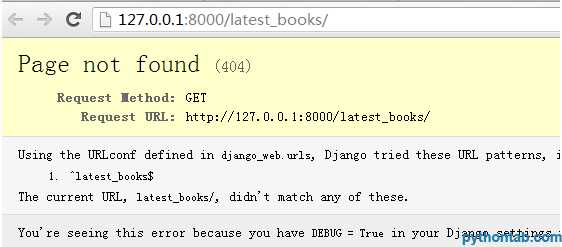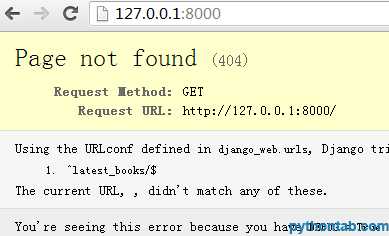django中“url映射规则”和“服务端响应顺序”
Posted
tags:
篇首语:本文由小常识网(cha138.com)小编为大家整理,主要介绍了django中“url映射规则”和“服务端响应顺序”相关的知识,希望对你有一定的参考价值。
1、django搜索路径
使用 import 语句时,Python 所查找的系统目录清单。
查看方式:
import sys
print sys.path
通常无需关心 Python 搜索路径的设置,Python 和 Django 会在后台自动帮你处理好。
2、url匹配模式
基本结构:
‘^需要匹配的url字符串$‘
PS:实际上最终完整的url串是http://根路径:端口号/需要匹配的url字符串
系统自动添加的部分‘http://根路径:端口号/‘
eg:url匹配模式:‘^latest_books/$‘
最终完整的url字符串:‘http://127.0.0.1:8000/latest_books/‘
1)^:匹配“子串头”。
eg:
‘^latest_books/‘
‘http://127.0.0.1:8000/latest_books/‘,
‘http://127.0.0.1:8000/latest_books/test1/‘,
‘http://127.0.0.1:8000/latest_books/test2/‘,
‘http://127.0.0.1:8000/latest_books/test1/aaa/‘
都会被匹配上。
2)$:匹配“子串结尾”。
eg:
‘latest_books/$‘
‘http://127.0.0.1:8000/latest_books/‘,
‘http://127.0.0.1:8000/updir_1/latest_books/‘,
‘http://127.0.0.1:8000/updir_2/latest_books/‘
都会被匹配上。
3)子串末尾是否包含‘/‘
默认情况下必须添加(django开发者的基本习惯),如果不添加将会出现如下情况:
from django.conf.urls import patterns, url, include
urlpatterns = patterns(‘‘,
(r‘^latest_books$‘, ‘django_web_app.views.latest_books‘),
)

如果子串末尾不想包含‘/‘,可在setting.py中添加设置:APPEND_SLASH=False
但是必须安装了CommonMiddleware才会起作用。
4)手动配置网站“根目录”
在不手动配置网站“根目录”对应“视图函数”的情况下,会出现如下情况:

手动配置“根目录”对应“视图函数”:
a)urls.py
from django.conf.urls import patterns, url, include
urlpatterns = patterns(‘‘,
(r‘^$‘,‘django_web_app.views.home_page‘),
(r‘^latest_books/$‘, ‘django_web_app.views.latest_books‘),
)
b)views.py
def home_page(request):
return render_to_response(‘home_page.html‘)
c)home_page.html
<!DOCTYPE html>
<html>
<head>
<title>my home page</title>
</head>
<body>
<h1>This is home page, welcome !</h1>
</body>
</html>
运行结果:

附:正则表达式基础
3、服务端响应url请求的执行顺序
1)项目结构
django_web
__init__.py
settings.py
urls.py
wsgi.py
django_web_app
__init__.py
admin.py
models.py
tests.py
views.py
templates
home_page.html
latest_books.html
manage.py
2)执行顺序
a)启动服务端——python manage.py runserver
获取setting.py文件中的配置,主要包括:
url映射关系文件路径:
ROOT_URLCONF = ‘django_web.urls‘
页面文件模板路径:
TEMPLATE_DIRS = (
os.path.join(BASE_DIR, ‘templates‘),
)
数据库配置:
DATABASES = {
‘default‘: {
‘ENGINE‘: ‘django.db.backends.mysql‘,
‘NAME‘: ‘django_db‘,
‘USER‘: ‘root‘,
‘PASSWORD‘: ‘feng‘,
‘HOST‘: ‘127.0.0.1‘,
‘PORT‘: ‘3306‘,
}
}
b)响应顺序
第一步:浏览器提交请求
http://127.0.0.1:8000/latest_books/
第二步:服务端根据请求的url在urls.py中进行匹配,并找到对应的“视图函数”
第三步:调用对应的“视图函数” 返回一个HttpResponse对象
第四步:django转换HttpResponse对象为一个适合的HTTP response,并返回给页面进行显示
文章来自:http://www.python和谐tab.com/html/2014/pythonweb_0529/791.html
以上是关于django中“url映射规则”和“服务端响应顺序”的主要内容,如果未能解决你的问题,请参考以下文章